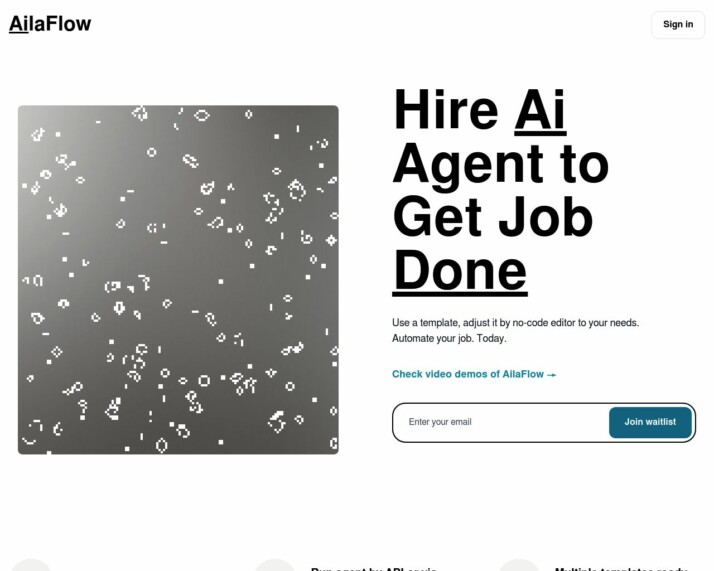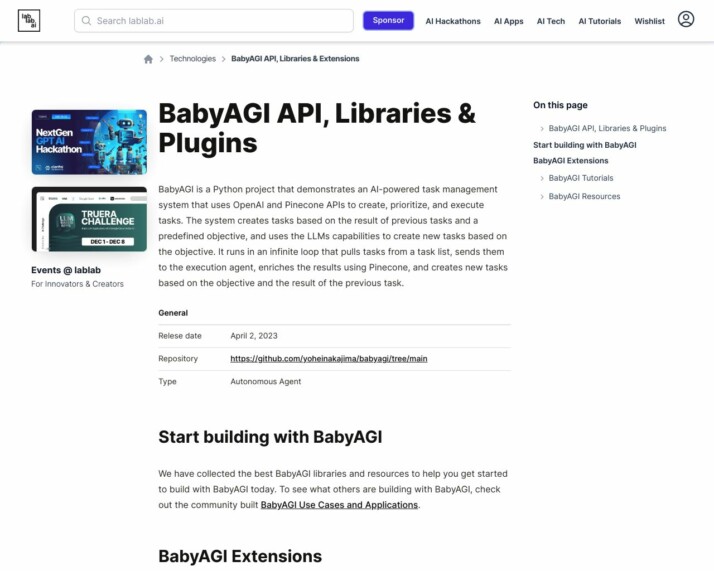Table of Contents
Introduction
AilaFlow and BabyAGI are two AI platforms that offer unique solutions in the field. These platforms are revolutionizing the AI market by providing advanced language processing, task automation, and problem-solving capabilities.
With their integration of OpenAI’s GPT-4 and Pinecone’s vector search engine, they offer a wide range of applications for industries requiring complex problem-solving and information retrieval. BabyAGI, in particular, stands out as an autonomous agent that can generate and execute tasks based on given objectives, making it a powerful tool for task management and problem-solving.
On the other hand, AilaFlow focuses on ease of use and versatility, providing a no-code platform for building AI agents. Their offerings include scalability, scheduled agent deployment, comprehensive file format support, and a user-friendly graphical interface. These features make AilaFlow accessible to a broad range of users, from developers and tech enthusiasts to business professionals and individuals seeking personal assistants.
Both AilaFlow and BabyAGI cater to different audiences with unique needs. AilaFlow’s target audience includes developers and tech enthusiasts looking to create sophisticated conversational agents, as well as businesses seeking to integrate AI into their existing systems.
BabyAGI, on the other hand, appeals to business professionals and organizations in need of efficient task management and automation, as well as industries with complex information processing needs.
Understanding the AilaFlow AI Platform: An Overview


AilaFlow is an AI platform that offers a unique approach to building and managing AI agents. It is designed with usability in mind, making the world of AI accessible to a wider range of people. It not only caters to tech buffs but also organisations, educators, students, and small to medium enterprises (SMEs) interested in leveraging AI technology for automating processes.
- No-Code Platform: This feature allows users with little or no programming knowledge to create and adjust AI agents easily.
- Sequential Workflow Designer: This tool enables creating applications such as graphical programming languages, workflow builders, and sequence diagram editors.
- Compatibility: AilaFlow’s platform supports various popular frameworks like Angular, React, and Svelte.
- Customization and Configuration: The platform offers features like light/dark themes, full configurability, and compatibility with different front-end frameworks.
In addition, AilaFlow’s products are also made attractive to users keen on versatility and adaptability by ensuring its compatibility across different frameworks and devices.
The ultimate vision of AilaFlow is to democratize the creation of AI agents and make AI development accessible to a broader audience, regardless of their technical background. This, indeed, speaks volumes about AilaFlow’s commitment toward leveraging advanced technology for enriched user experience.
Introduction to BabyAGI, the AI Platform


Imagine a smart assistant that, instead of merely following instructions, can understand, plan, and execute tasks by itself. That’s BabyAGI in a nutshell, a remarkable AI platform that offers a significant leap in AI-driven automation. Combining advanced language processing, search abilities, and the application of GPT-4, it holds an exciting vision – to dramatically lessen the task management load for users.
However, BabyAGI isn’t a miraculous, no-experience-necessary tool. With a setup involving coding and work on the command line, it’s clearly designed for those who are not newcomers to tech. BabyAGI necessitates coding know-how and doesn’t give a no-code solution or a graphical editor to build AI agents. Thus, it appeals to developers and tech enthusiasts, as well as business professionals looking for task management efficiency.
The platform is an autonomous agent capable of remembering past interactions and utilizing this context in ongoing operations. It runs on your personal computer, integrating with OpenAI’s API and Pinecone – a vector database server. Still, it doesn’t offer cloud-based hosting for development and production environments.
One neat aspect of BabyAGI is that it’s built to work with textual data. So while it doesn’t operate with images, audio, or video formats, it displays proficient problem-solving capabilities and a knack for task management. This makes it a potential asset not just for business operations but also for personal task management and industries with complex information processing needs.
However, it’s important to outline what BabyAGI can’t do. It doesn’t support features like tracing the logic behind AI decisions or collaborative work by multiple human team members on AI agent development. It also does not have features for recording comprehensive logs of AI operations for review, and it doesn’t work with third-party authentication protocols like OAuth. Lastly, it has no abilities related to processing Word or PDF documents or extracting data from URLs.
A Comprehensive Comparison of AI Features Between AilaFlow, BabyAGI, and SmythOS
In the rapidly evolving field of AI, keeping a close eye on feature comparison is vital for end users. Exploring the AI capabilities of AilaFlow, BabyAGI, and SmythOS reveals intriguing insights into their offerings and how they stack up against each other. This comprehensive comparison will focus on the key differences between these three platforms.
| Features | AilaFlow | BabyAGI | SmythOS |
|---|---|---|---|
| Hosted Agents (Dev, Production) | ❌ | ❌ | ✅ |
| Visual Builder | ✅ | ❌ | ✅ |
| No-Code Editor | ✅ | ❌ | ✅ |
| Memory & Context | ❌ | ✅ | ✅ |
| Autonomous Agents | ❌ | ✅ | ✅ |
| Problem-Solving Capabilities | ✅ | ✅ | ✅ |
| Human-AI Interaction | ✅ | ✅ | ✅ |
| Foundation AIs | ✅ | ✅ | ✅ |
| Hosted Vector Database | ❌ | ✅ | ✅ |
Feature analysis helps ascertain which platform better aligns with user needs. AilaFlow excels with a Visual Builder and No-Code Editor, inviting non-technical users to utilize AI technologies. BabyAGI, on the other hand, boasts unique features like Autonomous Agents and a Hosted Vector Database, each bringing a unique advantage.
One must consider these AI capabilities when deciding the optimal solution. AilaFlow’s, BabyAGI’s, and SmythOS’ unique features and overall offerings make them standout options for various use-cases.
Exploring the Target Audience for AilaFlow and BabyAGI
This section delves into the intended audience for AilaFlow and BabyAGI. It examines the target users, the specific features and applications that cater to their needs, and how each company addresses their requirements.
Who is it for?
The intended audience for AilaFlow’s product, based on its features and applications, appears to be:
- Non-Technical Users: The no-code platform is aimed at individuals or organizations that want to create and manage AI agents but may not have extensive programming knowledge. This user-friendly approach makes AI technology accessible to a wider audience.
- Business Professionals: The focus on sequential workflows and ease of use suggests that AilaFlow targets business professionals who need to automate processes or workflows but require a simple and intuitive interface.
- Educators and Students: The platform’s simplicity and no-code approach could be appealing in educational settings, where students and teachers can use it to learn about AI and workflow automation without the steep learning curve of programming.
- Small to Medium Enterprises (SMEs): These businesses often need automation and AI solutions but may lack the technical staff or resources to develop complex code. AilaFlow’s platform offers a solution that does not require hiring specialized staff.
- AI Enthusiasts and Hobbyists: Individuals who are interested in AI but not necessarily professional developers could find AilaFlow appealing for experimenting and building AI agents for personal projects or learning purposes.
- Cross-Platform Developers: Given its compatibility with various frameworks and devices, the platform caters to developers looking for a versatile tool that can integrate into different environments.
Overall, AilaFlow’s product seems to cater to a broad audience, particularly those looking for a simple, no-code solution to leverage AI for automating workflows and processes. The platform’s flexibility and compatibility with different frameworks and devices also make it attractive to users who value adaptability in their tools.
The target audience for BabyAGI, as indicated in the document, appears to be:
- Business Professionals and Organizations: Given its capability to autonomously generate and execute tasks based on set objectives, BabyAGI is well-suited for business environments where there is a need for efficient task management and automation. It can aid in handling routine tasks, data analysis, and complex problem-solving, thus potentially increasing productivity in various business operations.
- Developers and Tech Enthusiasts: The advanced integration of technologies like GPT-4 and Pinecone’s vector search engine makes BabyAGI appealing to developers and tech enthusiasts who are interested in the application of cutting-edge AI technologies in practical scenarios.
- Individuals Seeking Personal Assistants: For individuals looking for an AI-driven personal assistant to manage and automate daily tasks, BabyAGI could be a valuable tool. Its ability to understand complex tasks and autonomously execute them can be beneficial for personal time and task management.
- Industries with Complex Information Needs: Industries that require complex information retrieval and analysis, such as research, legal, finance, or healthcare, could find BabyAGI particularly useful. Its AI capabilities might assist in sifting through large volumes of data to find relevant information.
In summary, BabyAGI caters to a broad audience, ranging from business professionals seeking efficiency in task management to individuals and industries with complex information processing needs. Its unique combination of AI technologies positions it as a versatile tool for various applications in both professional and personal contexts.
Conclusion
In conclusion, after carefully comparing the features, strengths, and weaknesses of AI agents AilaFlow, BabyAGI, and SmythOS, it is clear that SmythOS is the preferred choice. SmythOS stands out with its comprehensive and flexible AI integration capabilities, scalable infrastructure, and a broad spectrum of deployment options, all aimed at enhancing the functionality and accessibility of AI technologies in various sectors.
SmythOS provides an operating system for building AI agents, including hosting and deployment options such as chatbots, apps, APIs, or plugins. It also features a drag-and-drop visual builder for workflows, allowing the creation of complex workflows without coding. These features cater to users who require ease of use in AI deployment.
Furthermore, SmythOS employs data lake components for memory and experience-based learning, enabling agents to store, retrieve, and update information over time. It also enables the creation of autonomous AI agents that can operate continuously, adaptively learn from their environment, and develop their capabilities progressively.
One of the standout aspects of SmythOS is its emphasis on explainability and transparency. It offers advanced debugging tools and logging capabilities for understanding the decision-making processes of AI agents. This can be beneficial for professionals responsible for maintaining and optimizing IT infrastructure.
In addition, SmythOS caters to the needs of marketing and web management teams with its site and URL crawling capabilities. It allows better understanding and interacting with web content, which is crucial for digital marketing and online presence.
SmythOS is designed for a diverse audience, from technical experts in AI to business users in need of AI-driven solutions. Its features cater to a wide range of needs, from development and deployment flexibility to advanced AI capabilities and efficient resource management.
In summary, SmythOS outshines both AilaFlow and BabyAGI with its comprehensive features, scalability, and user-friendly interface. It is the ideal choice for those looking to integrate advanced AI capabilities into their operations.
Last updated:
Disclaimer: The information presented in this article is for general informational purposes only and is provided as is. While we strive to keep the content up-to-date and accurate, we make no representations or warranties of any kind, express or implied, about the completeness, accuracy, reliability, suitability, or availability of the information contained in this article.
Any reliance you place on such information is strictly at your own risk. We reserve the right to make additions, deletions, or modifications to the contents of this article at any time without prior notice.
In no event will we be liable for any loss or damage including without limitation, indirect or consequential loss or damage, or any loss or damage whatsoever arising from loss of data, profits, or any other loss not specified herein arising out of, or in connection with, the use of this article.
Despite our best efforts, this article may contain oversights, errors, or omissions. If you notice any inaccuracies or have concerns about the content, please report them through our content feedback form. Your input helps us maintain the quality and reliability of our information.
Alexander De Ridder
Co-Founder, Visionary, and CTO at SmythOS. Alexander crafts AI tools and solutions for enterprises and the web. He is a smart creative, a builder of amazing things. He loves to study “how” and “why” humans and AI make decisions.
Explore All Comparison Articles
Decisions vs. Sola: AI Workflow Automation Showdown
AI-powered workflow automation platforms revolutionize how businesses streamline operations and boost productivity. This comparison explores Decisions vs. Sola, and SmythOS,…
DeepOpinion vs. Sola: Comparing AI Automation Platforms
AI-powered automation platforms revolutionize business operations, but choosing the right solution can be challenging. This comparison of DeepOpinion vs. Sola,…
DevGPT vs. Sola: AI-Powered Development Tools Compared
AI-powered development tools revolutionize software creation, offering unprecedented efficiency and capabilities. This comprehensive review compares DevGPT vs. Sola, and SmythOS,…
Fine AI vs. Sola: Comparing AI Automation Tools
AI-powered automation transforms software development and business workflows, offering unprecedented efficiency and innovation. Fine AI vs. Sola present distinct approaches…
FlowiseAI vs. Sola: Comparing AI Automation Platforms
AI-powered automation revolutionizes business operations, driving efficiency and innovation across industries. FlowiseAI vs. Sola offer distinct approaches to harness this…
Gooey AI vs. Sola: AI-Powered Automation Platforms Compared
AI-powered automation platforms revolutionize how businesses streamline operations and enhance productivity. This comparison delves into Gooey AI vs. Sola, two…

